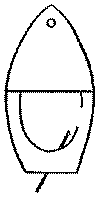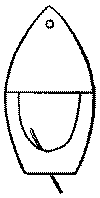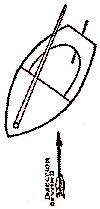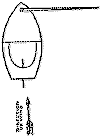By Dan Beard
See Also: Sailing Terms for Land Lubbers

Fig. 110
Starboard Helm
When you wish your boat to turn to the right push your helm to the left. This will push the rudder to the right and turn the boat in that direction. When you wish your boat to turn to the left push your helm to the right. In other words, starboard your helm and you will turn to the port (Fig. 110). Port your helm and you will turn to the starboard (Fig. 111).

Fig. 111
Port Helm
From a reference to the diagram you may see that when you port your helm you move the tiller to the port side of the boat, and when you starboard your helm you move your tiller to the starboard side of the boat (Fig. 110), but to ease your helm you move your helm toward the center of the boat-that is, amidships.
How to Sail a Boat
if you fasten the bottom of a kite to the ground, you will find that the wind will do its best to blow the kite over, and it the kite is fastened to the mast of a toy boat, the wind will try to blow the boat over.
In sailing a boat the effort of the wind apparently has but one object, and that is the upsetting of the boat. The latter being well balanced, is constantly endeavoring to sit upright on its keel, and you, as a sailor, are aiding the boat in the struggle, at the same time subverting the purpose of the wind to suit your own ideas. It is an exciting game, in which man usually comes out ahead, but the wind gains enough victories to keep its courage up.
Every boat has peculiarities of its own, and good traits as well as bad ones, which give the craft a personal character that lends much to your interest, and even all affects your sensibilities to the extent of causing you to have the same affection for a good, trustworthy craft that you have for an intelligent and kind dog or horse.
A properly balanced sailboat, with main sheet trimmed flat and free helm, should be as sensitive as a weathervane and act like one--that is, she ought to swing around until her bow pointed right into the "eye of the wind," the direction from which the wind blows. Such a craft it is not difficult to sail, but it frequently happens that the boat that is given to you to sail is not properly balanced, and shows a constant tendency to "come up in the wind"- face the wind-when you are doing your best to keep her sails full and keep her on her course. This may be caused by too much sail aft. The beat is then said to carry a weather helm.
Weather Helm--When a boat shows a constant tendency to come up in the wind. | |
Lee Helm--When a boat shows a constant tendency to fall off the wind-that is, when the wind blows her bow to the leeward. |
This is a much worse trait than the former, and a boat with a lee helm is a dangerous boat. It may be possible to remedy it by adding sail aft or reducing sail forward which should immediately be done.
In spite of the fact, already stated, that the wind's constant effort is to capsize a boat, there is little or no danger of a property rigged boat upsetting unless the sheets are fast or hampered in some way. When a sailboat upsets it is, of course, because the wind blows it over. Now, the wind cannot blow a boat over unless the boat presents some surface larger than its hull for the wind to blow against, and the sail is the only object that offers enough surface to the breeze to cause an upset.
If the sheet is slackened, the sail will swing around until it flaps like a flag and only the thin edge is presented to the wind; and a boat that a flag will upset is no boat for beginners to trust themselves in. True the boom may be very long and heavy enough to make it dangerous to let so much of it overboard, but this is seldom the case.
A good sailor keeps his eyes constantly on the sails and trims them to take advantage of the slightest favorable breeze. In place of losing control of his sail by letting go the sheets he will ease the tiller so as to "spill" part of the wind-that is, let the forward part or luff of the sail shake a bit. Or, in case of a sudden puff of wind, he may deem it necessary to "luff"-that is, let her shake-and slacken the sheets, too.
Trimmed Flat--Sheets hauled in until the boom is only a little to the leeward of the helm (Fig. 112). | |
Close-Hauled--Sheets trimmed flat and the boat pointing as near as possible to the eye of the wind. Then the sail cannot belly, and is called flat (Fig. 112). |
To Sail Close-Hauled

Fig. 112
Close Hauled
The skipper must watch that his sail does not flap or ripple at the throat, for that means that he is pointing too close to the wind and that some of the breeze is blowing on both sides of his sail, which even a novice can see will retard the boat.
Upon discovering a rippling motion at the luff of the sail put the helm up--that is, move the tiller a little to windward until the sail stops its flopping.
Before the Wind--When the wind is astern; sailing with the wind; sailing directly from windward to leeward (Fig. 113). |

Fig. 113
Before the Wind
In order to reach the desired point it is often expedient to sail before the wind, but unless the wind is light, beginners had better not try this. To sail before the wind you let your sheets out until the boom stands at almost right angles with the boat. Keep your eye on the sail and see that it does not flap, for if the man at the helm is careless and allows the boat to point enough away from the direction of the wind to allow the wind to get on the other side of the sail, the latter will swing around or jibe with such force as to endanger the mast, if it does not knock someone overboard.
The price of liberty is constant vigilance, and the price of a good sail is the same. I have seen a mast snapped off clean at the deck by a jibe, and once when out after ducks everyone was so intent upon the game that proper attention was not paid to the sail. The wind got round and brought the boom with a swing aft, knocking the captain of our boat club overboard. Had the boom hit him in the head and stunned him, the result might have been fatal.
Wing and Wing--When a schooner goes before the wind with one sail out at nearly right angles on the port side and the other in the same position on the starboard side she is said to be wing and wing, and presents a beautiful sight. | |
Tacking--Working to the windward by a series of diagonal moves. | |
Legs--The moves or diagonal courses made in tacking. |
It is apparent to the most unthinking observer that no vessel propelled by sail can move against the direct course of the wind that is, only powerboats can drive into the eye of the wind. But what cannot be accomplished in a direct manner can be done by a series of compromises, each of which will bring us nearer to the desired point.
First we point the boat to the right or left, as the case may be, as near to the wind as the boat will sail. Then we come about and sail in the other direction as close as practicable to the eye of the wind, and each time we gain something in a direct line.
When your boat changes its direction on a tack it is Done by "jibing" or "coming about."
Jibing--With the wind on the quarter, haul the main boom aft or amidships with all possible speed, by means of the main sheets (Fig. 115), and as the wind strikes the sail on the other side let it out as deliberately as possible until it reaches the position desired (Fig. 116). |

Figs. 114, 115, and 116
Jibing
Beginners should never attempt to jibe, for if there is more than a capful of wind, the sail will probably get away from them, and, as described in going before the wind, some disaster is liable to occur. Experts only jibe in light winds, and frequently lower the peak, so as to reduce sail, before attempting a jibe.
When you wish to come about see that all the tackle, ropes, etc., are clear and in working order, and that you are making good headway, then call out: "Helm's a-lee!" or "Ready about!" and push the tiller in the direction opposite to that from which the wind blows-that is, to the lee side of the boat. This will bring the bow around until the wind strikes the sail upon the side opposite to that which it struck before the helm was a-lee (Figs. 117, 118, 119, 120).

Figs. 117, 118, 119, & 120
Coming About
If you are aboard a sloop or schooner, ease off the jib sheet, but keep control of it, so that as the boat comes up to the wind you can make the jib help the bow around by holding the sheets so as to catch the wind aback. When the bow of the craft has passed the eye of the wind and the sail begins to fill give the order to make fast or trim the jib, and off you go upon the opposite tack, or on a new leg.
If the wind is light, or if, for any cause, the boat works slowly, you can sometimes help her by trimming in the main sheet when you let the jib sheet fly. In the diagram of coming about no jib is shown.
Wearing is a term sometimes used in place of jibing. |